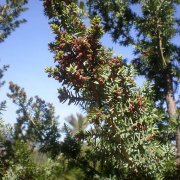Care of the shrub Juniperus oxycedrus or Prickly juniper |
|
The Juniperus genus, Cupressaceae family, comprises 60 species of shrubs and trees native to the Northern Hemisphere. Some species are: Juniperus oxycedrus, Juniperus horizontalis, Juniperus conferta, Juniperus communis, Juniperus chinensis, Juniperus californica, Juniperus osteosperma, Juniperus phoenicea, Juniperus squamata, Juniperus drupacea, Juniperus thurifera, Juniperus x pfitzeriana (hybrid), Juniperus brevifolia. Common names: Cade juniper, Prickly juniper, Prickly cedar, Sharp cedar. This species is native to the Mediterranean region. They are highly branched dioecious shrubs or trees that reach 5 meters (16.4 feet) in height. The fine, spiny evergreen leaves are light green in color and have 2 white lines on the upper side. The tiny flowers are not decorative. The fruits (galbules) take 2 years to mature and are reddish in color. These slow-growing conifers are used in small or medium-sized gardens as isolated specimens or to form hedges. Prickly juniper is appropriate for gardens by the sea and in pots for patios and terraces. Wood is highly prized in cabinetmaking. Juniperus oxycedrus can grow in full sun, shade and semi-shade exposures. It resists frost and the intense heat of the Mediterranean summer. The soil should never be acidic; they can grow in limestone, poor or stony soils. Transplantation or planting is done in the fall or spring. Water moderately all year long waiting for the substrate to dry completely; Prickly cedar resists drought well. Cade juniper does not need fertilizers or pruning (it does not resist it well). Juniperus oxycedrus can be attacked by fungi if there is excess moisture. Propagation from seed is a slow process (1-2 years to germinate); it's preferable to make cuttings or buy new plants at nurseries or garden centers. |
Images of the shrub Juniperus oxycedrus or Prickly juniper |
Find plants
Juniperus oxycedrus or Prickly juniper | Care and Growing
© 2025 FavThemes




